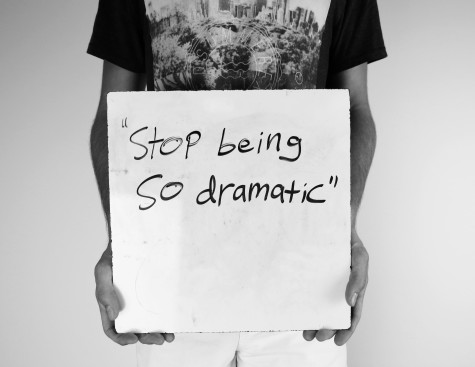Mental health stereotypes hinder healing
#StoptheStigma
Media by Abigail Gawart
Within the walls of MHS, 20 percent of students ages 13 to 18 are living with severe mental disorders, and about half of these persons have received no mental health services in the previous year. May stands as the national “Mental Health Awareness Month.” It aims to target the detrimental stigmas surrounding mental illness by educating society on the facts.
One in four adults−approximately 61.5 million Americans−will live with a mental illness this year, according to the National Alliance on Mental Illness. Within the walls of MHS, 20 percent of students ages 13 to 18 are living with severe mental disorders, and about half of these persons have received no mental health services in the previous year.
The evident commonality of mental illness amongst youth absolutely implores the need for change in the negativity largely associated with mental illness. As media, myths, and legends cloud societal understanding of mental illness, negative stigmas can leave persons with mental illness feeling isolated and often times, silent.
In opposition to these stigmatized stereotypes, May stands as the national “Mental Health Awareness Month.” Working to involve and educate society on the facts of mental health, community and nation based organizations target the detrimental effects of stigma.
LaDonna Haley, of Mental Health America, defines stigma as a negative concept that leads people to feel that something is so wrong with them that they are defective.
“The stigma around mental illness prevents people from seeking treatment, admitting it to themselves, or telling anyone about it because they sense that people will perceive them negatively,” Haley said. “There’s social stigma, where people intensely judge mental illness and it’s victims and there’s also personal stigma, where a person feels negatively about themselves.”
Haley said that media, such as movies and even the news, can often inappropriately and incorrectly portray mental illness.
“So often, persons, whose mental illness is not well treated, come to the public spotlight for some sort of action or behavior that they’ve engaged in,” Haley said. “Those sort of sensationalized, isolated incidents become what people associate with mental illness or the manifestation of persons with mental illness.”
In moving towards a better, destigmatized society, Haley said the most important thing is to become educated.
“Know the facts so that you can talk comfortably and knowledgeably in any sort of situation,” Haley said. “You can combat general stigma by standing up to one issue at a time and one person at a time.”
Haley said that it is important to understand the legitimacy of mental illness in that it isn’t something inherently wrong with an individual or a character defect.
“The more you are educated, the more you can break down common stereotypes and hopefully help someone in need,” Haley said. “Having good conversations is key to destigmatizing mental illness, so spread the idea that it’s okay to ask for help.”
Pressure to Produce
Aside from societal stigma, personal stigma can often exist between a student and his/her self, as certain symptoms regarding mental health can be produced by the high school environment itself.
We need to be more willing to empathize with people’s problems
— Brittany Fore, language arts teacher
Brittany Fore, language arts teacher, says she tends to see stress and anxiety to the extreme in students, which can inhibit abilities to carry out daily tasks.
“I do feel that students are more stressed now than they were just ten years ago,” Fore said. “I don’t know if it is because of expectations put on teens, but I do worry that some teens can be self diagnosing but not necessarily seeking treatment.”
Fore tries to communicate to her students that the transition from middle school to high school can be very stressful and it’s normal for students to feel like they’re hitting a wall and unable to produce at the level of their past efficiency.
“I think its also important for teens to encourage one-another to remember that your teen years really are some of the most stressful years of your life,” Fore said. “I think that we need to be more willing to empathize with people’s problems, instead of getting competitive about our level of stress because being aware and listening might be more helpful to someone than we might think.”
Incognito Illness
*Names have been changed for the protection of the sources
As a student battling depression, *Samantha McCoy said that mental illness related stigma have kept her from opening up about her condition.
“I feel really separated from people sometimes,” *McCoy said. “I definitely don’t walk around and tell people I have depression, but if someone noticed, it would mean a lot if they took an interest.”
*McCoy said she feels more judged than encouraged in most cases because she can be misconceived as an inherently sad person, instead of an individual with a legitimate illness.
“When I first found out I had depression, it was kind of a shock,” McCoy said.“I still keep it to myself for the most part because I would have to deal with all the judgemental comments and I probably wouldn’t be supported.”
In opposition to the average student, *McCoy said it can be very difficult to complete normal high school activities.
Having a mental illness feels like being a broken person.
— Rebecca Taylor
“I have a lot of anxiety, especially around other people and in the classroom,” *McCoy said. “I come home and stare at the math homework that doesn’t get done, which gives me even more anxiety.”
Also struggling with a depression related illness, *Rebecca Taylor said that her illness can leave her feeling ostracized and exhausted.
“Having a mental illness feels like being a broken person and this can lead people to not seek treatment,” Taylor said. “I believe a lot of this has to do with the way society views it.”
*Taylor said her support system is extremely crucial in her recovery and feels most in control when she’s exercising or working on herself.
“Everyone thinks that depressed people are dark people who can never get out of bed and only see the negative side to everything,” Taylor said. “I attempt to break these stereotypes everyday by pushing myself to live a normal life and thinking positively.”
Living With Distractions
While Mitchell Lee, junior, struggles with ADHD, he too said there are incorrect stereotypes associated with mental illness.
“People can sometimes view mental illness as someone making a big deal out of nothing, when that’s definitely not the case,” Lee said.
Lee said peers gave him trouble for getting extra time on the ACT because they viewed it as an unfair advantage.
“I’ll try to explain and convince them that I need the time but it’s just kind of annoying that they can’t see where I’m coming from,” Lee said. “People don’t have the same problems, so they wouldn’t understand.”
Similarly, Claire Green, junior, said that many people do not understand that mental illness can impact everyday tasks, such as focusing in class or finding the motivation to get out of bed each morning.
Green said her anxiety takes a large toll on her life.
“I tend to concentrate on things in my life that don’t go how I want,” Green said. “I sometimes realize that I think more about the bad things in my life than the good.”
Green said she especially has trouble taking tests because her heavy worrying causes her to perform worse.
Green recently began therapy in order to talk out her struggles without feeling any judgement.
“I feel like many people do not voice their struggle because of the many judgements others put upon them,” Green said.
Embracing Treatment
Cathy Westbury, mental health advocate and retired 26 year Rockwood counselor and Nationally Board Certified counselor, said we live in a country where mental illness isn’t highly centralized as an issue.

May stands as the national “Mental Health Awareness Month.” It aims to target the detrimental stigmas surrounding mental illness by educating society on the facts.
She said her job is to spend time collecting information on the physical and emotional behavior of students and then connect the student and the student’s family to therapists in the area.
“The first therapist a student sees isn’t necessarily the one for them,” Westbury said. “However, students should keep looking to find the right match because so much of mental illness can be treatable with therapy.”
Westbury said that in order to effectively destigmatize mental illness as a whole, it’s important to consider all aspects. Breaking down the stereotypes surrounding treatment methods, such as therapy or counseling, serves to ultimately reshape the societal acceptance and encouragement of the 25% of humanity living with a mental illness every day.
A Cohesive Cause
In order to fully embrace the cause, the MHS community has begun to unite under the intention of creating a destigmatized environment for persons with mental illness.
In January, Brenda Casey, MHS Crisis Intervention Specialist, gave a presentation to all MHS staff discussing common mental illnesses students face at MHS.
“We have noticed an incredible increase in the amount of mental illness that the students at Marquette are dealing with,” Casey said.
The presentation focused on the illnesses the guidance office sees the most in students: depression, bipolar disorder, ADHD, anxiety, and OCD, Casey said. The goal was to make staff members more aware of the warning signs associated with each illness in order to properly help those affected.
“It is through education that we more clearly understand,” Casey said. “Then not only can we help, but we can at least be empathetic and sympathetic to those who are struggling.
Casey said it would be a good idea to give a similar presentation to the student body in order to raise awareness and properly educate MHS students.
“Mental illness is very real,” Casey said. “I think we’re going to continue to see an increase in mental illness, but there are ways to better help people who are mentally ill.”
Your donation will support the student journalists of Marquette High School. Your contribution will allow us to purchase equipment and cover our annual website hosting costs. You may become a PATRON by making a donation at one of these levels: White/$30, Green/$50, Blue/$100. Patron names will be published in the print newsmagazine, on the website and once per quarter on our social media accounts.

Abigail Gawart, senior, is the multimedia editor for the Messenger and has been a part of the staff since her sophomore year. She enjoys performing for...

Rachel Schibler, senior, is the news editor of the Marquette Messenger. She plays lacrosse and coaches gymnastics. In her free time she enjoys making...




